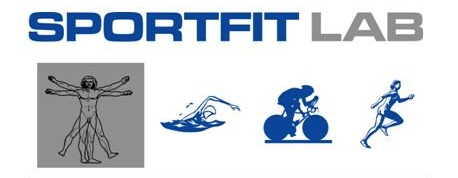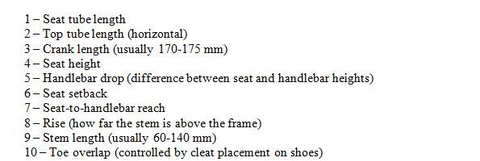Bike Fit FAQ
Why is Bike Fitting so important?
At 80-90 revolutions per minute, your legs go through more than 5000 forceful strokes per hour when cycling. If you ride more than a couple of hours per week, your bike must fit you well -- both for efficiency and to avoid injuries to your knees, hips, back, and shoulders. Click here for our fitting services, and read below for explanations of why professional fitting has become even more important to cycling enjoyment & success.
- 1. Can't I just use my inseam measurement to buy a bike?
Not really. First, your inseam tells you nothing about the rest of your body dimensions: for example, you may have a long torso or short arms. Second, your inseam doesn't take into account your riding style: you may ride more upright for comfort, or bend over low for more speed. This is especially critical for triathlon bikes, because you bend extremely low to achieve "aero" position. Third, bike sizes are no longer consistent: a "52" of one model may have a completely different shape/size from a "52" of another model -- even within the same brand!
- 2. What does size "52" mean? And why can't I use that to buy a bike?
In the old days, most bikes were made of round, metal tubes joined together. A size "52" meant the seat tube (from the bottom bracket to the seat post which slides inside it) and the top tube (horizontal tube you stand over) were both 52 centimeters in length. When using inseam measurements, some people assume that the bike "size" should be about 66% of their inseam. Unfortunately, with new carbon and aluminum bikes, a size "52" bike may have no 52-cm dimension anywhere on it! Some use the top tube length to name the bike size; some use the seat tube length; and some just use a ballpark estimate. Some manufacturers have even given up on numerical sizing, calling their bikes "small, medium, or large." So, you just can't rely on bike sizes to help you much.
- 3. Why not just go to shops and try out bikes for feel?
Test-riding bikes is highly overrated. First, proper fit is the most important characteristic affecting the feel of a bike -- and a test bike is rarely fitted for you. Second, differences in bike frames are really minor -- while differences in other components (wheels, gears, etc.) can make a huge difference. If any one bike was significantly faster, you'd see all the pros riding that bike. Finally, can you really tell -- in a 10-minute test ride -- how a bike will feel after many miles of riding? Not only is the test bike not adjusted properly for you, things like tires and tire pressure can affect the "feel" of a bike more than the frame itself. Most shops depend on high volume sales: they have every incentive to convince you that the bike they're selling will fit you well...or can be made to fit you with some part changes. Many riders looking for a "deal" convince themselves a sale bike "feels good" -- only to find out they were talking themselves into the wrong purchase. A bike that's a bad fit can only be minimally adjusted -- you may be stuck with a very expensive mistake. We have a track record of fitting each rider to the CORRECT bike for his/her body, riding style, and budget. We have ordered custom and non-custom bikes, based on fitting, for years -- yet we have never had an unsatisfied buyer.
- 4.How does bike fitting help in buying a bike?
A pre-purchase fitting is done on a fitting bike -- at Sportfit Lab, the GURU Dynamic Fit Unit, the most advanced fitting bike in the world. This bike can be adjusted to ANY size and shape, simulating any production bike. Even better, we use it to find YOUR ideal riding position. Then, you can use those measurements to shop only for bikes which will fit perfectly, without major part changes -- you won't waste time on bikes that won't fit you well in the long run. Interested in a specific model? We can simulate that bike, to see if it will work for you! If you're new to cycling, or buying your first triathlon bike, we make sure to account for your future progress in cycling fitness, so the bike will be comfortable both now and in the future. We take the guesswork out of bike shopping, so you shop with confidence!
- 5. What if I already have a bike?
You'll be amazed how much difference a professional fitting can make. From beginners to elite cyclists, we have helped hundreds of riders gain power, increase comfort, and prevent serious injuries. Using our knowledge of physiology and biomechanics, we look at all aspects of your cycling: your body dimensions, your fitness, your riding style -- even your shoes and pedals. We go through a step-wise process, correcting imbalances and improving riding posture, until you are optimally powerful AND comfortable. If part changes are needed, we'll advise you and offer a full selection of parts at great prices. We guarantee every fitting we perform, and have numerous testimonials from happy cyclists.
- 6. Will bike fitting make me faster? How?
Speed on the bike is primarily a product of (a) how much force (power) you can put into the pedals, vs. (b) how much aerodynamic resistance you have to overcome. As your speed increases, the force of the air against you increases exponentially; we generally say that above 19 mph, it becomes a major force against your forward motion. Fitting can improve speed by improving BOTH factors. To improve your total power output, we optimize your body position to take advantage of your muscles' strongest arc, based on your size, leg dimensions, flexibility, and strength. To reduce aerodynamic drag, we work to reduce your frontal area, i.e. the area that is being resisted by the air -- provided we can do that without compromising your power output, endurance, and comfort. Of course, most of your speed is determined by fitness: the strength of your legs and your cardiovascular system.
- 7. How important are pedals and shoes?
Pedals are one of the three "contact points" (seat and hands are the others) where your body interacts with your bike. Because your legs supply the power, the pedal interface is critical to efficient power and speed. If you ride only recreationally, you may want basic flat pedals, which can be used with any flat shoe. But most serious riders (and certainly those who race) use "clipless" pedals, which -- despite their name -- clip into the bottom of cycling shoes. These pedals allow a smooth and powerful pedaling motion. However, they must be fitted correctly to your shoes, via "cleats" that screw into the soles of the shoes. There are also several types of clipless pedals, including SPD (like on most spin bikes and mountain bikes), SPD-SL (triangular shaped), Look (similar to SPD-SL), Speedplay (little round pedals), and others. See us for help in choosing the right pedals, and fitting them properly to your shoes. Cleat alignment and shoe fitting can be critical in preventing knee or hip pain, as well as producing consistent power throughout your pedal stroke.
- 8. What about the bike seat?
The bike seat, or saddle, is a key part of your bike and your performance. It's where you apply most of your weight, so it must support you in comfort -- but also allow powerful pedaling without restriction. If your seat is uncomfortable, you will (perhaps unconsciously) fidget and move weight onto your hands and feet -- causing fatigue, discomfort, or even injury in those areas. Foot and hand numbness, knee pain, and even shoulder pain can sometimes be traced to saddle problems. However, saddle fit is quite personal -- no two riders have the same shape and same sensitivity. That's why we offer Gebiomized Saddle Mapping, which allows you to see the actual pressure imprint your bottom makes on the saddle as you ride; and allows us to find the best saddle for your posture and riding style. We also offer a SADDLE DEMO PROGRAM, so you can give each seat a full test -- on several long rides -- before you have to purchase it.
- 9.What are the Stack and Reach measurements used for?
To standardize bike frame comparisons, most fitters (and an increasing number of manufacturers) now rely on STACK and REACH dimensions (see diagram below). The “stack” is standardized to mean the vertical height of the top of the head tube – the highest point of the frame under the handlebar stem – from the center of the bottom bracket (the center of rotation of your crankset). Thus, a bike with a greater stack measurement will generally have a higher front end, with handlebars sitting up higher than bikes with lesser stack measurements.
The frame’s “reach” is standardized to mean the horizontal length from the center of the bottom bracket to the top of the head tube. So, you can see that the stack and reach form X and Y coordinates which allow us to compare frame geometries. Typically, a more “aggressive” geometry – made for aerodynamic riding and racing – will have a longer reach and a shorter stack. A more “relaxed” geometry – often better for comfort or endurance riding – will have a shorter reach and a taller stack, so you can sit more upright.
The stack and reach measurements allow you to compare frames of different brands and "sizes", to determine how they REALLY differ in dimensions. In other words, stack and reach supersede the nominal "size" of the bike: you can use them to compare any two frames, regardless of frame "size."
Unfortunately, even stack and reach don’t tell the entire story of a bike’s geometry, or how it will fit YOUR body. First, we have the problem of seat tube angles changing the EFFECTIVE reach of the bike: two bikes with the same listed “reach” measurement can have different effective reach lengths, if their seat tube angles differ. When this happens, the “reach” measurements may be the same, but the “seat X” measurement (see diagram) will differ. The seat or saddle “X” is the horizontal distance from the bottom bracket to the seat, which will depend on both the angle of the seat tube and the height of the seat.
Second, we have the problem of stack measurements: although they tell you how high the FRAME is in front, they don’t tell you exactly how high the HANDLEBARS sit! Why is this so? Because bikes vary in how much steerer tube – the part on which the stem is fitted – extends above the top of the frame. Some bikes’ handlebars sit very low – just above the frame. Others’ are raised 2-4 centimeters above the frame, with “spacers” inserted between the frame and the handlebar stem. This can significantly change the height of the handlebars. [Don’t forget that stems also vary, in length and angle, which contributes to the final position of the handlebars]. This is why, as fitters, we lock into “handlebar X/Y” dimensions (see figure) to determine ideal positioning.
Lastly, we have the problem of body geometry. As you know, people differ in their dimensions and ratios: some have longer limbs and some shorter, even at the same overall height. Thus, bike measurements can only tell you so much – that’s why professional bike fitting is so important, both before and after purchasing a bike.


